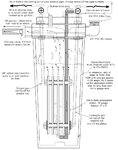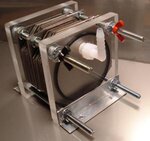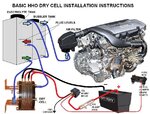Vermes
Advanced Member level 4
Presented here examples of installation of HHO generators were not verified, tested, etc. When you decide to create a generator, you must be aware of the dangers ecountered during the construction and operation of such a device. Note that the HHO gas is explosive and far-reaching precautions should be taken. The use of incorrect additives to the solutions may result in production of hazardous substances such as chlorine, which in combination with hydrogen may undergo a self-detonation.
At these times of global crisis and still growing fuel prices, we search for new ways to save money. Owners of petrol cars may have an additional installation of LPG, but cars with diesel units are deprived of such opportunity. Of course, mounting such an installation is possible, however, its cost could cover several years of spending on conventional fuel. For some time, installations of generator which provides additional fuel as a mixture of hydrogen with oxygen - HHO have become very popular. This type of system works with any type of engine, both diesel and petrol/LPG.
What is HHO?
Hydrogen is the most abundant element in the universe, it is present on earth in the form of water. Many car manufacturers are considering hydrogen as a high-performance fuel and it is supposed to drive the next generation of vehicles. It can be simply burned in the piston engine and be used to produce electricity in fuel cells. The most important fact is that the only product of burning is water, which is an environmental friendly product. That gas can be produced on an industrial scale by the thermal decomposition of water (the temperature above 2000 degrees Celsius), and chemical reactions such as the reaction of methane with oxygen and steam with coke, etc. Hydrogen can also be accessed at home. It is very simple and can be done in several ways, eg by the reaction of a metal with an acid, or magnesium burning in the steam. HHO generators use the phenomenon of electrolysis, which is done to water with the addition of KOH, or salt. As a result of the reaction, a highly combustible mixture of oxygen and hydrogen is produced.
Unfortunately, although it is quite easy to produce hydrogen, its storage is rather problematic. There are two ways you can do it. The first one – gaseous hydrogen can be compressed under very high pressure (up to 350 bar). Despite such high pressure, quantity of energy gained from a comparable amount of fuel is still ten times less. To offer a decent range for an average car, a larger part of the luggage space should be spent on the gas tank. The high pressure forces the use of much stronger vessel wall which increases its weight.
BMW and General Motors work on a technology of hydrogen storage in the liquid state. Unfortunately, this involves a considerable energy input because the gas must be cooled to its critical temperature of -240 degrees Celsius. The energy density is much higher than in the case of compression. Liquid hydrogen was used as a drive for space rockets. This technology is now being tested in a prototype BMW 5 Series burning traditional fuel and hydrogen from an auxiliary tank.
Construction of the generator:
Onboard generator allows the production of HHO to date without the need to store. Home made devices allow to generate a few liters of gas per minute, while the solutions offered by the producers allow to generate a bit more gas. The device consists of a water tank in which the electrodes are placed in the form of plates made of stainless steel. Current flow forces the movement of electric charges, whose carriers are both positive and negative ions. If the voltage between the electrodes reaches a certain value (breakdown voltage), there is the rapid growth of current intensity and reduction of water molecules. The following figure presents a simple construction of the generator based on standard water filter construction. Standard threaded holes were used to drain the generated gas. Electrodes outputs were placed in additional holes. Plates were arranged in reverse polarity at a distance of about 3mm. There is an additional pipe that supplies a small amount of exhaust improving gas bubbles detachment from the cell plates. The optimum temperature for operation is 60-70 degrees Celsius. This type of generator is called an immersion generator.

Figure 1. Construction of a generator in water filter housing.
The newest constructions of generators are made in „Dry Cell” technology, without the tank with immersed plates of generator. In this case, the liquid flows between the electrodes , which are sealed with special spacers. Most devices of this type are protected from the outside using transparent plexiglass plates and screwed with long screws which are the outputs of the electrodes. According to the opinion of producers and owners of such devices, the performance compared to „Wet Cell” increases by up to 100%. An additional advantage is the smaller amount of heat generated (smaller amount of electrolyte around the electrodes).

Figure 2. Generator „Dry Cell”
Generator is the main element of the system which requires some additional components for its correct operation. Produced gas can not be given directly to the intake because it may contain steam. For this purpose, small reservoirs, so-called „bubblers” are used. Gas in those reserviors is coming out through the tube palced in water and simple bubbles. Except the reduction of steam, it also prevents the system from reverse explosion of gas accumulated in the collector. The dry cell requires an additional circuit pump which pumps electrolyte between the generator and the liquid tank. It is recommended to apply a check valve before the intake manifold. The simplest electrical system includes a connection of electrodes with the accumulator through a relay controlled from the cab or the ignition signal. The figure below shows a simple HHO installation.

Figure 3. Typical HHO installation in a car
According to the tests provided by manufacturers and DIY constructors, the best effects were obtained by applying a PWM generator, which produces the appropriate characteristics of supplying the cell. Correctly powered generators produce several percent more gas.
Giving more amount of fuel (other than usual) to the engine requires a change of control unit software, or at least emulation of the lambda sensor operation. Cheating the computer was used in LPG installations of the second generation. Therefore it is a highly explosive gas, you should seriously consider the option of change of the intake manifold to the metal one in your car if it is made of plastic.
Energy taken from the alternator can not exceed its maximum value. The amount of produced gas depends on the value of flowing current. Manufacturers claim that only 10-12A is enough to generate sufficient amount of gas which is able to support the engine. But how a closed circuit can spend energy to produce its own fuel? Of course, there are systems which allow you to increase the efficiency of the internal combustion engine such as turbocharger, but in this case it is unlikely that the balance was positive. Although the principle of operation is reasonable, the calorific value of the expanded gas is very low compared to the same amount of petrol.
At these times of global crisis and still growing fuel prices, we search for new ways to save money. Owners of petrol cars may have an additional installation of LPG, but cars with diesel units are deprived of such opportunity. Of course, mounting such an installation is possible, however, its cost could cover several years of spending on conventional fuel. For some time, installations of generator which provides additional fuel as a mixture of hydrogen with oxygen - HHO have become very popular. This type of system works with any type of engine, both diesel and petrol/LPG.
What is HHO?
Hydrogen is the most abundant element in the universe, it is present on earth in the form of water. Many car manufacturers are considering hydrogen as a high-performance fuel and it is supposed to drive the next generation of vehicles. It can be simply burned in the piston engine and be used to produce electricity in fuel cells. The most important fact is that the only product of burning is water, which is an environmental friendly product. That gas can be produced on an industrial scale by the thermal decomposition of water (the temperature above 2000 degrees Celsius), and chemical reactions such as the reaction of methane with oxygen and steam with coke, etc. Hydrogen can also be accessed at home. It is very simple and can be done in several ways, eg by the reaction of a metal with an acid, or magnesium burning in the steam. HHO generators use the phenomenon of electrolysis, which is done to water with the addition of KOH, or salt. As a result of the reaction, a highly combustible mixture of oxygen and hydrogen is produced.
Unfortunately, although it is quite easy to produce hydrogen, its storage is rather problematic. There are two ways you can do it. The first one – gaseous hydrogen can be compressed under very high pressure (up to 350 bar). Despite such high pressure, quantity of energy gained from a comparable amount of fuel is still ten times less. To offer a decent range for an average car, a larger part of the luggage space should be spent on the gas tank. The high pressure forces the use of much stronger vessel wall which increases its weight.
BMW and General Motors work on a technology of hydrogen storage in the liquid state. Unfortunately, this involves a considerable energy input because the gas must be cooled to its critical temperature of -240 degrees Celsius. The energy density is much higher than in the case of compression. Liquid hydrogen was used as a drive for space rockets. This technology is now being tested in a prototype BMW 5 Series burning traditional fuel and hydrogen from an auxiliary tank.
Construction of the generator:
Onboard generator allows the production of HHO to date without the need to store. Home made devices allow to generate a few liters of gas per minute, while the solutions offered by the producers allow to generate a bit more gas. The device consists of a water tank in which the electrodes are placed in the form of plates made of stainless steel. Current flow forces the movement of electric charges, whose carriers are both positive and negative ions. If the voltage between the electrodes reaches a certain value (breakdown voltage), there is the rapid growth of current intensity and reduction of water molecules. The following figure presents a simple construction of the generator based on standard water filter construction. Standard threaded holes were used to drain the generated gas. Electrodes outputs were placed in additional holes. Plates were arranged in reverse polarity at a distance of about 3mm. There is an additional pipe that supplies a small amount of exhaust improving gas bubbles detachment from the cell plates. The optimum temperature for operation is 60-70 degrees Celsius. This type of generator is called an immersion generator.

Figure 1. Construction of a generator in water filter housing.
The newest constructions of generators are made in „Dry Cell” technology, without the tank with immersed plates of generator. In this case, the liquid flows between the electrodes , which are sealed with special spacers. Most devices of this type are protected from the outside using transparent plexiglass plates and screwed with long screws which are the outputs of the electrodes. According to the opinion of producers and owners of such devices, the performance compared to „Wet Cell” increases by up to 100%. An additional advantage is the smaller amount of heat generated (smaller amount of electrolyte around the electrodes).

Figure 2. Generator „Dry Cell”
Generator is the main element of the system which requires some additional components for its correct operation. Produced gas can not be given directly to the intake because it may contain steam. For this purpose, small reservoirs, so-called „bubblers” are used. Gas in those reserviors is coming out through the tube palced in water and simple bubbles. Except the reduction of steam, it also prevents the system from reverse explosion of gas accumulated in the collector. The dry cell requires an additional circuit pump which pumps electrolyte between the generator and the liquid tank. It is recommended to apply a check valve before the intake manifold. The simplest electrical system includes a connection of electrodes with the accumulator through a relay controlled from the cab or the ignition signal. The figure below shows a simple HHO installation.

Figure 3. Typical HHO installation in a car
According to the tests provided by manufacturers and DIY constructors, the best effects were obtained by applying a PWM generator, which produces the appropriate characteristics of supplying the cell. Correctly powered generators produce several percent more gas.
Giving more amount of fuel (other than usual) to the engine requires a change of control unit software, or at least emulation of the lambda sensor operation. Cheating the computer was used in LPG installations of the second generation. Therefore it is a highly explosive gas, you should seriously consider the option of change of the intake manifold to the metal one in your car if it is made of plastic.
Energy taken from the alternator can not exceed its maximum value. The amount of produced gas depends on the value of flowing current. Manufacturers claim that only 10-12A is enough to generate sufficient amount of gas which is able to support the engine. But how a closed circuit can spend energy to produce its own fuel? Of course, there are systems which allow you to increase the efficiency of the internal combustion engine such as turbocharger, but in this case it is unlikely that the balance was positive. Although the principle of operation is reasonable, the calorific value of the expanded gas is very low compared to the same amount of petrol.